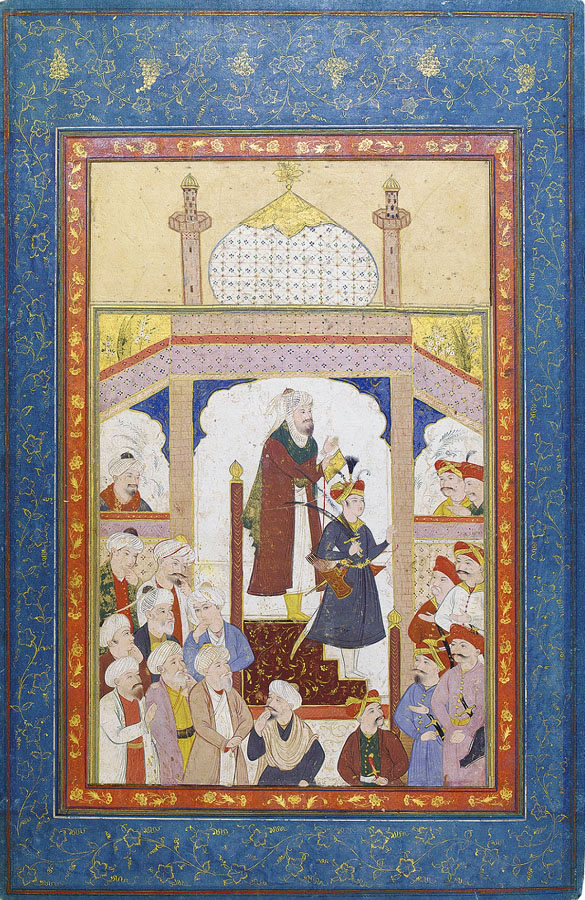Location: Present Whereabouts Unknown.
Mount: turquoise blue with gold 36.0 x 23.5 cm.; orange collar.
Painting: 24.6 x 15.3 cm.
Text references: J.K., p.148.
See Savory, SA_1979, p.43 for this event in the History of Shah ʿĀbbās
The date of this event: Winter 907/1501.
The event is the simultaneous coronation of Shah Esmāʿil and the adoption of Eṣnā ʿAšari Shiʿism as the official state religion, argueably the most significant event of the entire Safavid period. The text specifies the masjed-e jomʿa in Tabriz as the location of the ceremony, and states that on Friday, the kaṭib, who was a shi'a, and Esmāʿil, went to the mimbar. There Esmāʿil brandished the sword of the twelfth imam and stood like a shining sun. Two other versions of this event were painted by Moʿin, ms.L, f. 74 and ms.M, SE-60 -- of the three versions, this one is the most formalized and the most elaborate. The composition is more symetrically disposed than either of the other versions, and more figures are portrayed -- ten religious dignitaries on the left balanced by seven qezelbāš on the right - as compared to seven and five repectively in the Tehran version (ms.M, SE-60) and eight and six respectively in the British Library version (ms.L, f. 74).
In this depiction, a tiled central dome flanked by two slender minarets, represents the top portion of the mosque. Vertically below the dome is a tiled lintel and two columns symetrically disposed, which frame a multilobed arch and white panel. Against this light background, on the top step of the mimbar is the white-bearded kaṭib with turban and long flowing coat, reading from a book, and stretching his left hand over Esmāʿil’s head. Two steps below the top stands young Esmāʿil, then only thirteen years old, dressed in a ceremonial blue knee-length coat and red qezelbāš tāj. With his right hand he holds the sword given him by the Twelfth Imam (see ms.N, jk_088) in ceremonial gesture that denotes both the adoption of Eṣnā ʿAšari Šiʿism as the official state religion, and the commencement of Safavid rule over Iran. Curiously, the kaṭib and Esmāʿil both face to the right, while in the two other variants they face left. At the base of the mimbar, are ten religious dignitaries; balancing them on the right is a group of seven qezelbāš.
Painting references:
Anderson Gallery, November 30 - December 1, 1923, Lot 293.
Christies London, 4 April 2006, Lot 141
Provenence: Formerly in the Collection of Reżā Khan Monif in New York. It was sold at his estate sale at Anderson Galleries on 30 November - 1 December 1923 for $37.50. Christies pre-lot notes from their 2006 sale states that the painting was from the Estate of Rudolf M. Riefstahl. Rudolf Riefstahl Sr. wrote the introduction to the Monif Estate sale in 1923 and died in 1936. It is probable, but not certain, that Riefstahal purchased this painting at the Monif estate sale.
Photo courtesy of Christie's. ©Christie's Images Ltd. 2012
Robert Eng
Last Updated: June 26, 2012 | Originally published:June 26, 2012
